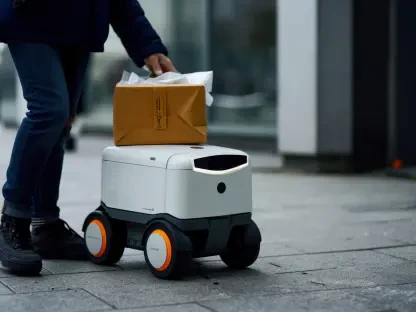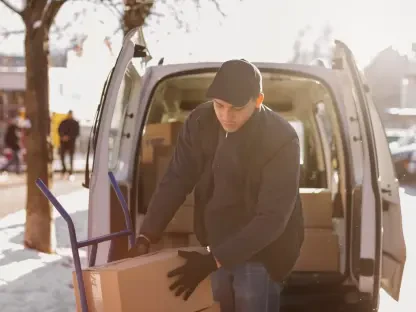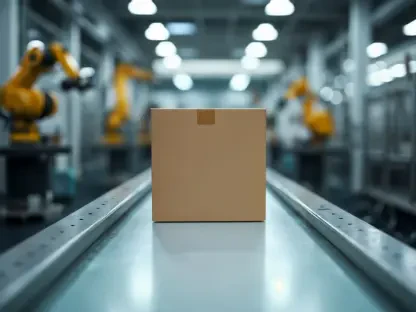The environmental impact of last-mile delivery has become a pressing concern, as this critical stage in the logistics chain is responsible for a significant portion of emissions within the industry. As e-commerce continues to soar, the need for a sustainable approach to last-mile delivery grows more urgent. The logistics industry identifies this as an area with considerable potential for reducing the overall carbon footprint. In recent years, last-mile delivery has been attributed to up to 30% of the industry’s carbon dioxide emissions, a figure that can reach over 50% in densely populated areas. The increase in e-commerce demand has amplified this footprint, highlighting the necessity for immediate intervention and the pursuit of greener alternatives.
Understanding Last-Mile Delivery’s Environmental Footprint
The Impact of Fossil Fuel Reliance
Last-mile delivery processes are heavily reliant on traditional fossil fuel-driven vehicles, which contributes significantly to carbon emissions. This reliance underscores the inefficiencies inherent in the logistics of transporting goods from central hubs to individual customer locations. The widespread use of gasoline and diesel vehicles not only adds to the carbon dioxide emissions but also exacerbates urban air pollution and environmental degradation. In the context of urban centers, the environmental ramifications are particularly pronounced, making the need for cleaner transportation solutions ever more critical. The compounding effects of these emissions demand a reevaluation of existing delivery practices, pushing for innovations that can mitigate these impacts meaningfully.
Challenges with Current Practices
The core challenge with last-mile delivery lies in its inefficiencies and the logistical complexities it presents. This final delivery phase is marked by numerous small-sized drop-offs scattered across wide geographic areas, requiring substantial fuel consumption and contributing to traffic congestion. Over the years, the demand for expedited deliveries has further intensified these complications, emphasizing speed often at the expense of sustainability. The fragmentation of delivery routes complicates consolidation efforts, resulting in higher emissions and increased operational costs. To address these challenges, stakeholders across the industry are actively seeking viable alternatives that can lead to both environmental benefits and enhanced operational efficiencies.
Strategies for Sustainable Last-Mile Delivery
Transition to Electric Vehicles and Alternative Fuels
Transitioning to electric vehicles (EVs) has emerged as a pivotal strategy for reducing the carbon footprint of last-mile delivery operations. EVs present a zero-emission alternative to traditional delivery vehicles and can seriously mitigate the environmental impact of the logistics industry. The adoption of EVs also brings economic advantages, as they are often cheaper to operate and maintain than their fossil fuel counterparts. Reduced fuel costs and fewer mechanical components translate to lower overall expenses. Incentives from governments have played a crucial role in this shift, providing subsidies and tax breaks that encourage companies to invest in electric fleets, thereby accelerating the transition toward sustainable delivery systems.
Embracing Micromobility Solutions
In urban environments, micromobility solutions like cargo bikes and e-bikes offer a sustainable alternative to traditional delivery vehicles. These nimble forms of transportation navigate congested city streets efficiently, reducing both emissions and noise pollution. Cargo bikes can potentially replace more than half of existing urban van deliveries, offering a cleaner, quieter means of navigating urban landscapes. Micromobility solutions are well-suited for short, urban routes and have demonstrated their ability to provide efficient delivery while decreasing congestion. By adopting these solutions, delivery companies can achieve quicker delivery times and contribute significantly to improved urban air quality.
Innovations in Technology and Logistics
The Role of Drones and Autonomous Vehicles
The integration of drones and autonomous vehicles into last-mile delivery represents a transformative step toward sustainability. These innovative technologies offer a glimpse into a future where remote and difficult-to-reach locations can be serviced efficiently and with lower emissions. Drones, in particular, excel in rapid delivery scenarios, reducing the environmental impact during urgent deliveries. The use of electric autonomous vehicles further cuts emissions and reduces reliance on manual labor. This technological shift holds promise not only for reducing emissions but also for improving the reach and efficiency of logistical operations, laying the groundwork for a future of dependable and eco-friendly deliveries.
Optimizing Delivery Routes with Advanced Algorithms
The optimization of delivery routes through advanced algorithms and artificial intelligence is another critical development for sustainability. By minimizing travel distances and fuel consumption, logistical operations can notably decrease their environmental impact. Real-time data allows for dynamic route adjustments, accommodating traffic conditions and unforeseen delays with ease. Additionally, predictive analytics enhance planning, ensuring that resources are allocated efficiently to meet demand with the least environmental strain. These innovations pave the way for streamlined logistical operations that align with sustainability objectives, ultimately contributing to a greener, more efficient supply chain.
Rethinking Infrastructure and Consumer Behavior
Micro-Consolidation Centers and Urban Hubs
The establishment of micro-consolidation centers and urban hubs provides an integral approach to reducing the environmental toll of last-mile delivery. These smaller distribution points strategically placed in proximity to urban populations minimize the overall travel distance for deliveries. By serving as advantageous launch pads for environmentally-friendly vehicles like cargo bikes and electric vans, these centers further limit emissions. Such infrastructure rethinking facilitates a smoother, more sustainable flow of goods within dense city environments, diminishing the logistical complexities associated with last-mile delivery in urban territories while offering noticeable improvements in efficiency.
The Emergence of Out-of-Home Delivery Networks
Out-of-home delivery networks, featuring parcel lockers and designated pick-up points, offer an effective strategy for lowering emissions and optimizing delivery processes. Through the consolidation of multiple deliveries to singular locations, these networks curtail the need for individual drop-offs, which are often inefficient and emission-heavy. This approach not only optimizes resource utilization but also encourages consumer participation. By retrieving parcels at their convenience, customers play a role in the sustainability efforts, reducing delivery-related emissions and supporting more collaborative solutions to logistic challenges.
Overcoming Barriers to Sustainable Delivery
Despite promising progress, the path to sustainable last-mile delivery is not without hurdles. One significant barrier is the substantial upfront investment required for transitioning to electric vehicle fleets. This expense, coupled with the limited availability of EV charging infrastructure, poses a formidable challenge to widespread adoption. Strategic investments and targeted infrastructure development are essential to address these issues and ensure the feasibility and effectiveness of the shift toward sustainable transportation solutions. Similarly, fostering public-private partnerships may help facilitate infrastructure expansion and expedite the move toward more sustainable logistics operations.
Collaborative Efforts for a Greener Future
The environmental impact of last-mile delivery is increasingly problematic, as this crucial logistics stage significantly contributes to the industry’s emissions. With the explosive growth of e-commerce, developing a sustainable approach to last-mile delivery is more urgent than ever. The logistics sector views this stage as having substantial potential to reduce its overall carbon footprint. In recent times, last-mile delivery has been responsible for as much as 30% of the industry’s carbon dioxide emissions, with this figure potentially exceeding 50% in densely populated urban areas. The rising demand from e-commerce has exacerbated this environmental burden, underscoring an immediate need for intervention. Addressing this issue through innovative solutions is not just advisable but essential. Various strategies, like electric and hybrid vehicles, optimized delivery routes, and local hubs to minimize travel distances, are being considered. Rapid action and commitment to greener practices are paramount to mitigating the adverse effects on the environment.









